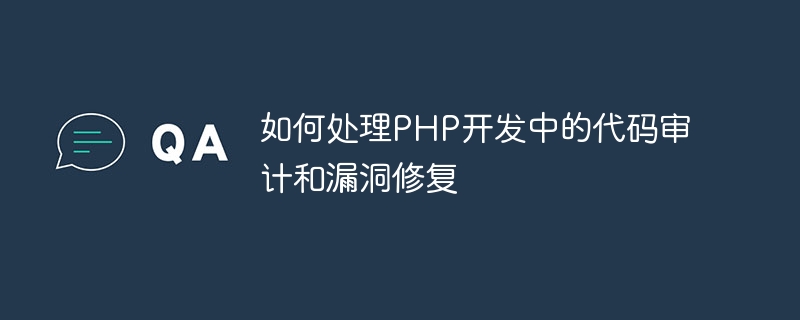

How to handle code auditing and vulnerability repair in PHP development
With the rapid development of the Internet, PHP, as a widely used programming language, is used in websites and plays an important role in application development. However, due to its open source nature, PHP code can also be easily exploited by hackers, causing security vulnerabilities. For PHP developers, code auditing and vulnerability repair are issues that must be paid attention to. This article will detail how to handle code auditing and vulnerability fixing in PHP development, with specific code examples.
1. Code Audit
Code audit refers to a comprehensive and in-depth inspection of the code to discover security risks and vulnerabilities. In PHP development, code audit mainly includes the following aspects:
PHP applications often need to receive input data from users, such as form submission, URL parameters, etc. These input data require strict validation to prevent security vulnerabilities such as SQL injection and cross-site scripting attacks (XSS). The following is a simple input validation example:
<?php
$username = $_POST['username'];
if (!preg_match("/^[a-zA-Z0-9]{6,15}$/", $username)) {
echo "用户名只能包含字母和数字,长度为6-15个字符";
exit();
}
?>In PHP code, you need to pay attention to protecting sensitive information, such as database connections, API keys, etc. . It must be ensured that this information cannot be obtained or exploited by malicious users. The following is a simple example of sensitive information protection:
<?php $db_host = 'localhost'; $db_user = 'root'; $db_password = 'password'; $db_name = 'database'; // 在实际使用中,可以将敏感信息存放在独立的配置文件中,通过include或require加载 // 或者使用环境变量、加密文件等方式进行保护 ?>
Permission control is an important means to ensure system security. PHP developers need to carefully consider user permissions and corresponding functional access controls in their applications. The following is a simple permission control example:
<?php
// 检查用户是否具有编辑文章的权限
if ($_SESSION['userRole'] != 'admin') {
echo "无权限操作";
exit();
}
// 执行编辑文章的操作
// ...
?>2. Vulnerability Repair
When code audit finds security vulnerabilities, developers need to fix these vulnerabilities as soon as possible to ensure the security of the system. In PHP development, vulnerability repair mainly includes the following aspects:
SQL injection is a common attack method. The attacker constructs Specific database query statements to obtain sensitive data or perform malicious operations. The way to fix SQL injection vulnerabilities is generally to use prepared statements or parameterized queries. The following is an example of using prepared statements to fix SQL injection vulnerabilities:
<?php
$username = $_POST['username'];
$password = $_POST['password'];
$stmt = $pdo->prepare('SELECT * FROM users WHERE username = ? AND password = ?');
$stmt->execute([$username, $password]);
$user = $stmt->fetch();
if ($user) {
// 用户登录成功
} else {
// 用户名或密码错误
}
?>Thereby stealing user information or obtaining user permissions. The main method to repair XSS vulnerabilities is to filter and escape user input. The following is an example of using the htmlspecialchars function to fix XSS vulnerabilities:
<?php // 显示用户提交的评论内容 $content = $_POST['content']; echo htmlspecialchars($content, ENT_QUOTES, 'UTF-8'); ?>
The file upload vulnerability means that the attacker uploads a file containing malicious code. Execute these files to gain system privileges. Methods to fix file upload vulnerabilities include limiting file types, file sizes, etc., and checking and filtering uploaded files on the server side. The following is an example of limiting uploaded file types:
<?php
$allowedTypes = ['image/jpeg', 'image/png'];
$fileType = $_FILES['file']['type'];
if (in_array($fileType, $allowedTypes)) {
// 处理文件上传
} else {
echo "只能上传jpeg和png格式的图片";
exit();
}
?>Summary:
Code auditing and vulnerability repair are important links in PHP development and are crucial to ensuring system security. Through reasonable code auditing and timely vulnerability repair, the risk of system attacks can be effectively reduced. I hope the introduction and examples in this article can help PHP developers better perform code auditing and vulnerability repair work.
The above is the detailed content of How to handle code auditing and bug fixing in PHP development. For more information, please follow other related articles on the PHP Chinese website!